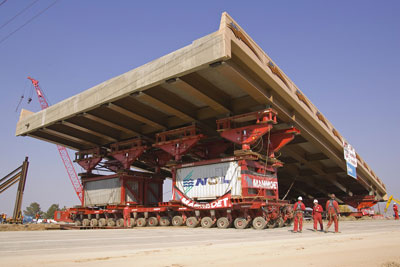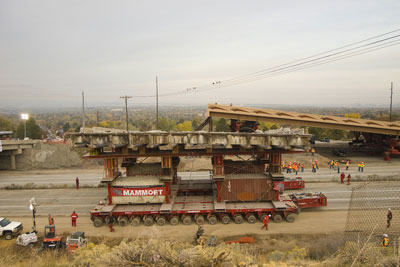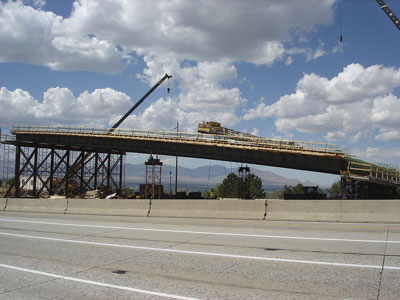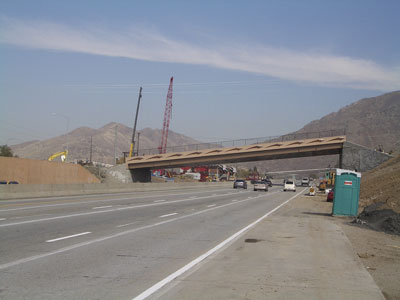U.S. Department of Transportation
Federal Highway Administration
1200 New Jersey Avenue, SE
Washington, DC 20590
202-366-4000
Focus
| Accelerating Infrastructure Innovations |
Publication Number: FHWA-HRT-08-009
Date: December 2007
Printable Version (.pdf, 0.3 mb)
Accelerated bridge construction (ABC) techniques cut road closures and detours from 6 months to a single weekend and saved $4 million in road user costs during the Utah Department of Transportation's (UDOT) recent replacement of the 4500 South bridge over the I-215 East Loop in Salt Lake City.
After evaluating project costs and user costs, UDOT decided that an ABC strategy was the best way to go. Championing the use of the new strategy were Shana Lindsey, UDOT's Director of Research and Bridge Operations, and Jim McMinimee, UDOT Director of Project Development, as well as the staff of UDOT's Salt Lake Region 2 office. "This innovation let us accomplish the work that needed to be done and not impact the driving public," says Lindsey. The project was supported by $1 million in funding from FHWA's Highways for LIFE program. "Highways for LIFE provided the seed money for the project, which enabled us to go ahead and use an accelerated strategy," says Lindsey.
Using prefabricated bridge elements, the superstructure of the new 4-lane, 52-m-long (172-ft), and 3-million-pound concrete and steel bridge was constructed offsite over a period of 4 months. Meanwhile, the abutments for the new bridge were constructed underneath the existing bridge without impacting traffic. The weekend installation process began with closing I-215 to traffic at 9 p.m. on Friday, October 26, 2007. On Saturday morning, the old bridge was removed using self-propelled modular transporters (SPMTs). SPMTs are multi-axle, computer-controlled platform vehicles that can move bridge systems with precision to within a fraction of an inch. The vehicles can move in any horizontal direction, while maintaining their payload geometry and keeping equal axle loads. SPMTs also have vertical lift. Their use provides an efficient solution for bridge replacements on high-volume roads, reducing traffic disruptions and increasing worker safety. Because of the grade and slope of the site and terrain changes, UDOT's project was the most complex to use SPMTs to date in the United States.
 |
| The Utah Department of Transportation used self-propelled modular transporters (SPMTs) to install the prefabricated superstructure of the 4500 South bridge in Salt Lake City in October 2007. |
On Sunday morning, the SPMTs were used again to lift the new bridge into place. "Both the removal and the installation went very well," says McMinimee. They also attracted considerable public interest and media attention, with thousands of spectators coming throughout the weekend to watch the innovative process. The road reopened on Monday morning, nearly 6 hours ahead of schedule. What would normally require 6 months of road closures and detours was accomplished in a single weekend.
Before embarking on the I-215 project and using SPMTs for the first time, UDOT conducted a scanning tour to other States that have used ABC techniques or SPMTs, including Louisiana, New York, and Florida. The tour allowed UDOT to ask questions and learn from other States' experiences, laying the groundwork for its project.
As part of the Highways for LIFE program and to provide a similar boost to others, UDOT invited neighboring Western States to come watch the bridge removal and installation and then stay for a 3-hour workshop on ABC and the use of SPMTs. The workshop attracted 150 highway agency representatives, contractors, and consultants.
While using SPMTs was an additional cost of nearly $800,000, for UDOT this was offset by the reduced user costs. "UDOT is championing the idea of looking at total project costs that include road user costs," says McMinimee. "We spent more on construction but we saved road users $4 million." "This project was also very important to gaining support in Utah for using innovative strategies," adds Lindsey. "It went exactly according to plan." From UDOT to area motorists and residents, the project was a success for the entire community.
The project's success has also brought momentum to planning accelerated bridge projects. For example, UDOT will use SPMTs to replace 13 bridges on I-80 in 2008. "The economy is tied directly to traffic flow," notes Lindsey. "We're using taxpayer dollars and everyone benefits when we use innovation to prevent lane closures and accomplish the work faster. It was a good thing to be able to bring the SPMT technology to Utah."
For more information on the 4500 South bridge removal and replacement, contact Daniel Hsiao at UDOT, 801-965-4638 (email: dhsiao@utah.gov).
 |
 |
 |
| UDOT used SPMTs to remove the old 4500 South bridge (top). The superstructure of the new bridge was constructed offsite over a period of 4 months (middle). Following installation of the new bridge, I-215 reopened to traffic after a single weekend of work (bottom). |